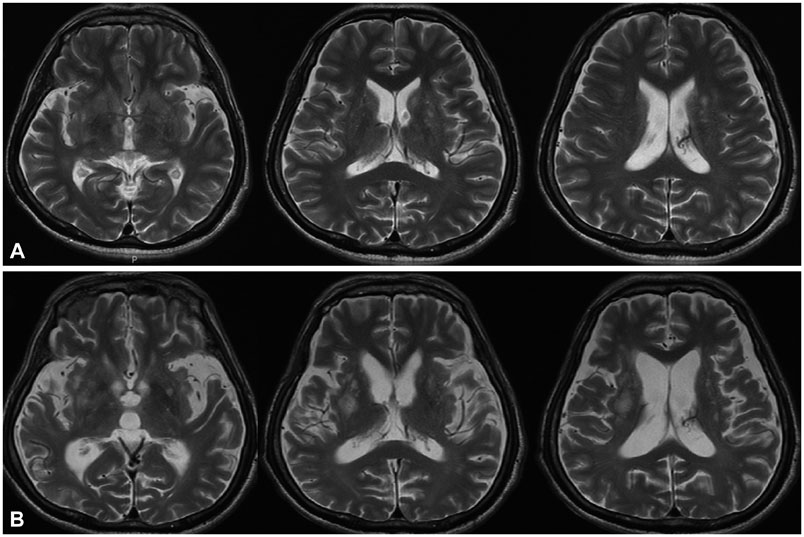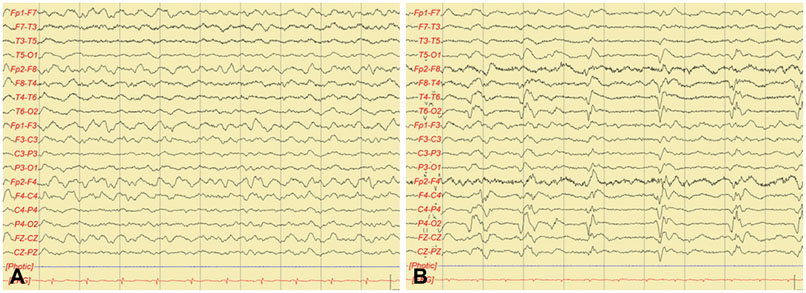Dement Neurocogn Disord.
2015 Dec;14(4):172-175. 10.12779/dnd.2015.14.4.172.
Hashimoto's Encephalopathy with Positive 14-3-3 Protein in the Cerebrospinal Fluid and Atypical Course Mimicking Creutzfeldt-Jakob Disease
- Affiliations
-
- 1Department of Neurology, Soonchunhyang University Seoul Hospital, Soonchunhyang University School of Medicine, Seoul, Korea. jisunkim@schmc.ac.kr
- KMID: 2442936
- DOI: http://doi.org/10.12779/dnd.2015.14.4.172
Abstract
- BACKGROUND
Creutzfeldt-Jakob disease (CJD) shares common clinical features with Hashimoto's encephalopathy (HE). The 14-3-3 protein is a relatively sensitive and specific marker of CJD but is not commonly detected in HE. We report the case of a patient with HE with unusual features including positive 14-3-3 protein in the cerebrospinal fluid (CSF) and an atypical course mimicking that of CJD.
CASE REPORT
A 64-year-old male was admitted due to acute-onset cognitive dysfunction. HE was suspected based on increased titers of anti-thyroid microsomal antibody and an excellent response to steroid. However, 14-3-3 protein was detected in the CSF and a recurrent attack with progressive cognitive decline, pyramidal symptoms and myoclonus mimicking CJD occurred. Cognitive dysfunction showed progressive worsening and the response to steroid treatment was decreased.
CONCLUSIONS
14-3-3 protein could be considered a general marker of neuronal destruction and not specific to CJD. The clinical manifestations of HE are variable and its diagnosis is difficult due to the lack of a specific phenotype and reliable diagnostic criteria. We recommend that patients with clinical features of CJD and antithyroid antibodies should be considered for empirical steroid treatment for HE, despite a positive result for 14-3-3 protein.
MeSH Terms
Figure
Reference
-
1. Chong JY, Rowland LP, Utiger RD. Hashimoto encephalopathy: syndrome or myth? Arch Neurol. 2003; 60:164–171.2. Steinhoff BJ, Zerr I, Glatting M, Schulz-Schaeffer W, Poser S, Kretzschmar HA. Diagnostic value of periodic complexes in Creutzfeldt-Jakob disease. Ann Neurol. 2004; 56:702–708.
Article3. Utsumiya K, Arakawa R, Fujimoto S, Ueyama H, Kumamoto T. [A case of steroid-responsive encephalopathy with positive 14-3-3 protein of the cerebrospinal fluid clinically resembling Creutzfelt-Jakob disease]. Rinsho Shinkeigaku. 2004; 44:618–622.4. Vander T, Hallevy C, Alsaed I, Valdman S, Ifergane G, Wirguin I. 14-3-3 protein in the CSF of a patient with Hashimoto's encephalopathy. J Neurol. 2004; 251:1273–1274.
Article5. Doherty CP, Schlossmacher M, Torres N, Bromfield E, Samuels MA, Folkerth R. Hashimoto's encephalopathy mimicking Creutzfeldt-Jakob disease: brain biopsy findings. J Neurol Neurosurg Psychiatry. 2002; 73:601–602.
Article6. Seipelt M, Zerr I, Nau R, Mollenhauer B, Kropp S, Steinhoff BJ, et al. Hashimoto's encephalitis as a differential diagnosis of Creutzfeldt-Jakob disease. J Neurol Neurosurg Psychiatry. 1999; 66:172–176.
Article7. Schröter A, Zerr I, Henkel K, Tschampa HJ, Finkenstaedt M, Poser S. Magnetic resonance imaging in the clinical diagnosis of Creutzfeldt-Jakob disease. Arch Neurol. 2000; 57:1751–1757.
Article8. Hernández Echebarría LE, Saiz A, Graus F, Tejada J, García JM, Clavera B, et al. Detection of 14-3-3 protein in the CSF of a patient with Hashimoto's encephalopathy. Neurology. 2000; 54:1539–1540.
Article9. Zerr I, Bodemer M, Gefeller O, Otto M, Poser S, Wiltfang J, et al. Detection of 14-3-3 protein in the cerebrospinal fluid supports the diagnosis of Creutzfeldt-Jakob disease. Ann Neurol. 1998; 43:32–40.
Article
- Full Text Links
- Actions
-
Cited
- CITED
-
- Close
- Share
- Similar articles
-
- A Case of Probable Creutzfeldt-Jakob Disease with Coexistence of the Features of Hashimoto Encephalopathy
- White Matter Lesions in a Patient With Creutzfeldt-Jakob Disease
- Anesthetic management in patients suspected of Creutzfeldt-Jakob disease -A case report-
- A case of Creutzfeldt-Jakob disease
- Creutzfeldt-Jakob Disease Mimicking a Stroke as Initial Manifestation



